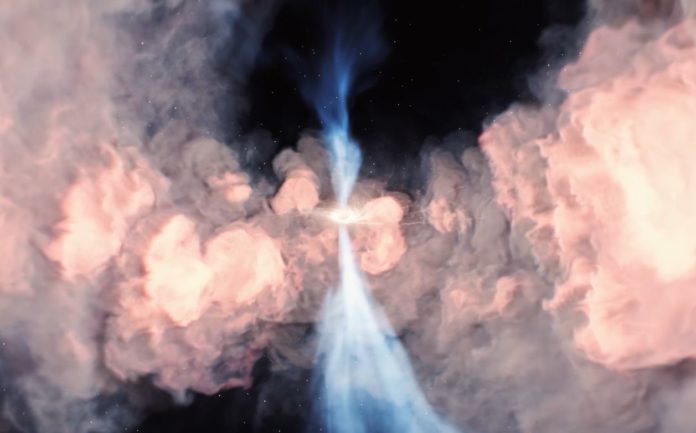Light echo and high-energy neutrino reveal a catastrophic cosmic event.
Astronomers have observed a big, enormous star being torn apart by a black hole, resulting in a spectacular explosion. One of the brightest bursts ever detected, as well as a delayed infrared “light echo” emitted by heated dust, are evidence of this cosmic disaster. A particularly high-energy neutrino was also recorded by the IceCube observatory at the South Pole, which was most likely caused by this “tidal disruption event.”
When a star approaches a supermassive black hole too closely, its fate is sealed: the massive gravity pushes on the star, causing massive tidal forces in the stellar material. Because the forces of attraction are higher on the side facing the hole than on the rear, the star is ripped apart in a “tidal disruption event” (TDE) and its material is ripped apart into tiny threads – it gets spaghettized.
A research team led by Simeon Reusch from the German electron synchrotron in Hamburg has now followed a particularly violent star death. The first signal from this event was captured by the Zwicky Transient Facility (ZTF) in California, an observatory specifically designed to detect transient cosmic events. On August 10, 2019, the telescope detected an unusually strong burst of radiation, which slowly abated over the next few weeks.
The astronomers determined that the burst of radiation occurred in the heart of a galaxy 4.4 billion light-years away, at the center of which sits a black hole with a mass of 35 million times the mass of the Sun. On the basis of its spectroscopic and photometric characteristics, AT2019fdr was classified as a possible tidal disruption event, although the extreme flare of an active galaxy core could not be ruled out.
To gain clarity, astronomers observed AT2019fdr’s evolution over more than a year in all parts of the electromagnetic spectrum – from gamma rays to radio.
The observations revealed that the enormous outburst of brightness must actually have been a tidal disruption event – the rupturing of a star by a black hole.
“This tidal disruption event may even have been the most luminous transient cosmic phenomenon ever observed,” says co-author Marek Kowalski from DESY.
The researchers believe that the ruptured star must have been a massive sun in order for enough stuff to gather and eventually glow on the accretion disk.
Also indicative of such a stellar catastrophe was a glaring infrared “light echo” captured by NASA’s WISE infrared telescope a few months after the optical beam output had faded.
“The dust echo in the infrared range is a key signature of the tidal disruption event,” explains Reusch. “This gave away the nature of this transient object.”
The cause of this delayed thermal radiation is a huge cloud of dust in the vicinity of the black hole, which was heated up by the star’s death and the radiation released in the process. This caused the dust to radiate in the infrared range. Due to geometric effects, this light echo only reached its maximum a year after the giant star ruptured.
The IceCube observatory at the South Pole also captured a high-energy neutrino that could have been produced by the event. This could be the second time IceCube has picked up a particle from a shattered star, marking a breakthrough for the field of neutrino astronomy. “Neutrinos give us insights into cosmic objects that are not possible with light and other electromagnetic radiation,” says Kowalski, DESY’s head of neutrino astronomy. “With electromagnetic radiation, we look at the surface of an object. Neutrinos, however, reach us unhindered from the interior .”
In particular, the combining of electromagnetic radiation observations with neutrinos provides novel insights. This is known as multi-messenger astronomy because the messengers in the two domains, photons and neutrinos, are of vastly different natures. Radio wave measurements, for example, revealed that this phenomenon is a cosmic particle accelerator. The neutrino’s independent measurement backs up this claim, indicating that it is a proton (hydrogen nuclei) accelerator but not an electron (far lighter) accelerator. Further analysis of the IceCube measurement data should yield more precise results.
Image Credit: Desy
You were reading: Black Hole Ruptures A Giant Star
